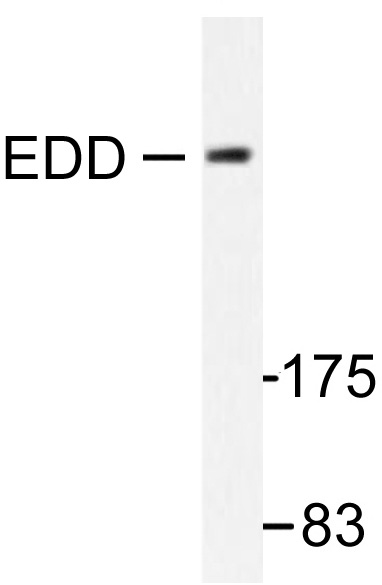EDD (UBR5) Rabbit Polyclonal Antibody
Other products for "EDD"
Specifications
| Product Data | |
| Applications | IHC, WB |
| Recommended Dilution | Western blot: 1/500-1/1000. Immunohistochemistry on paraffin sections: 1/50-1/200. |
| Reactivities | Human, Mouse |
| Host | Rabbit |
| Clonality | Polyclonal |
| Immunogen | Synthetic peptide, corresponding to amino acids 1-50 of Human HYD. |
| Specificity | This antibody detects endogenous levels of EDD protein. (region surrounding Thr14) |
| Formulation | Phosphate buffered saline (PBS), pH 7.2 with 50% Glycerol. State: Aff - Purified State: Liquid purified Ig fraction Preservative: 0.02% Sodium Azide |
| Concentration | 1.0 mg/ml |
| Purification | Affinity-chromatography using epitope-specific immunogen and the purity is > 95% (by SDS-PAGE) |
| Conjugation | Unconjugated |
| Storage | Store undiluted at 2-8°C for one month or (in aliquots) at -20°C for longer. Avoid repeated freezing and thawing. |
| Stability | Shelf life: one year from despatch. |
| Predicted Protein Size | ~ 309 kDa |
| Gene Name | ubiquitin protein ligase E3 component n-recognin 5 |
| Database Link | |
| Background | EDD (for E3 identified by Differential Display) is a progestin-regulated gene that was isolated from T-47D human breast cancer cells. Based on sequence homology, EDD appears to be a human homolog of the Drosophila hyperplastic discs (hyd) gene, a tumor suppressor gene that is required for control of imaginal disc growth (2). EDD contains a HECT domain in the carboxy terminus. HECT domain-containing proteins function as ubiquitin-protein ligases, or E3 enzymes. EDD has been shown to bind to ubiquitin, and like other HECT family proteins, may function as an E3 ubiquitin-protein ligase. |
| Synonyms | EDD, EDD1, KIAA0896 |
| Reference Data | |
| Protein Families | Druggable Genome |
| Protein Pathways | Ubiquitin mediated proteolysis |
Documents
| Product Manuals |
| FAQs |
| SDS |
{0} Product Review(s)
0 Product Review(s)
Submit review
Be the first one to submit a review
Product Citations
*Delivery time may vary from web posted schedule. Occasional delays may occur due to unforeseen
complexities in the preparation of your product. International customers may expect an additional 1-2 weeks
in shipping.






























































































































































































































































 Germany
Germany
 Japan
Japan
 United Kingdom
United Kingdom
 China
China




